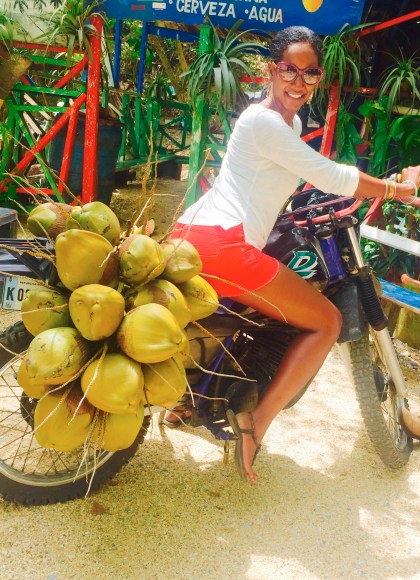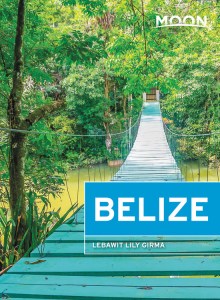Maya Ruins in Belize: The Mundo Maya
It’s estimated that at the height of the Classic Period, the area known as Belize was home to at least one million Maya. We’re lucky that today Mayan ruins in Belize are so numerous; Belize is home to 11 partly or fully excavated, protected Mayan archaeological sites. Each had an intricate role in Mayan history and architecture. The Belize Institute of Archaeology (NICH) manages all archaeological sites.
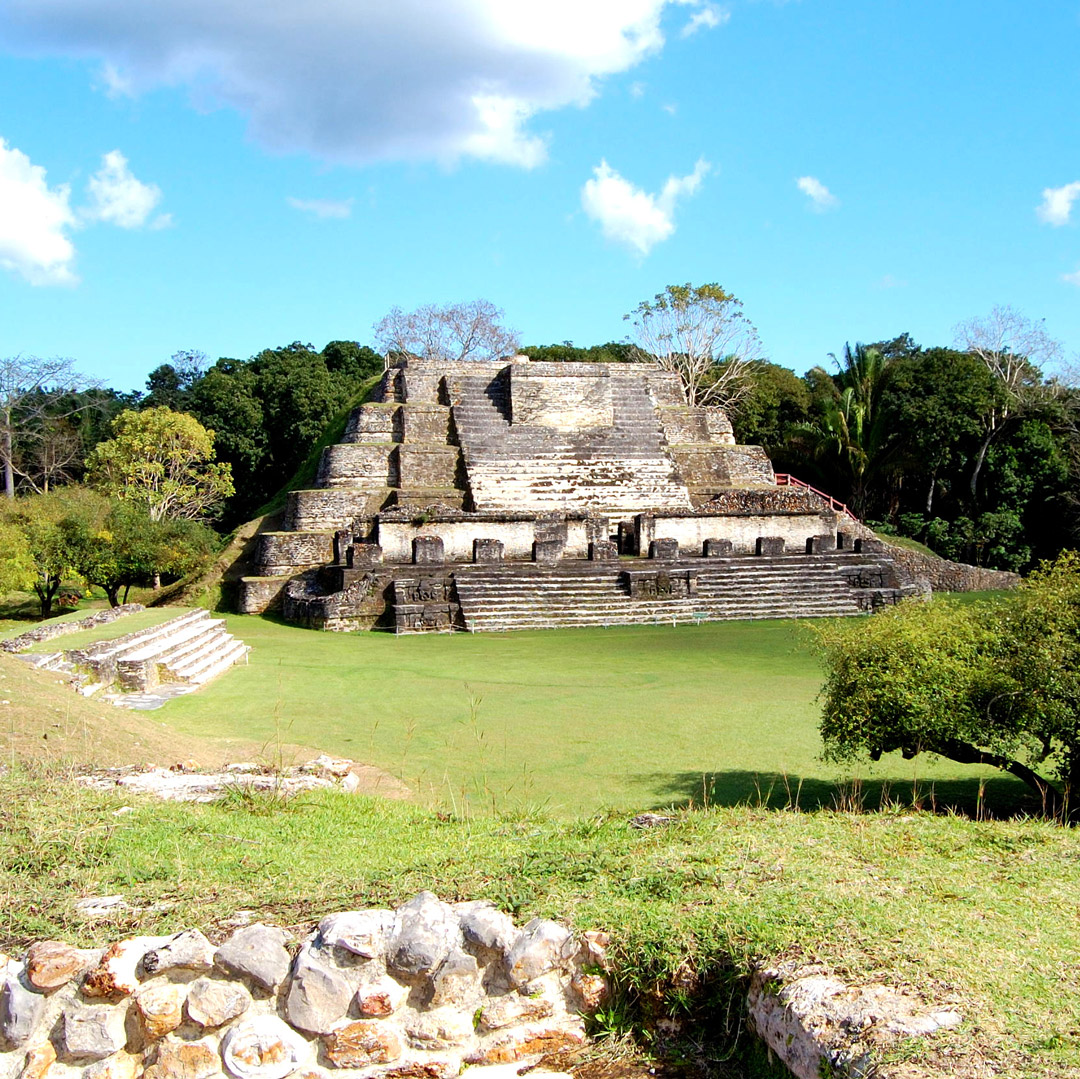
Altun Ha
Altun Ha (9am-5pm daily, US$5) is 34 miles north of Belize City and has become one of the more popular day trips for groups and individuals venturing from Belize City, Ambergris Caye, and Caye Caulker; it is the most visited Mayan ruins in Belize. A Mayan trading center as well as a religious ceremonial site, it is believed to have accommodated about 10,000 people. Archaeologists, working amid a Mayan community that has been living here for several centuries, have dated construction to about 1,500-2,000 years ago. It wasn’t until the archaeologists arrived in 1964 that the old name, Rockstone Pond, was translated into the Mayan words Altun Ha.
Altun Ha spans an area of about 25 square miles, most of which is covered by trees, vines, and rainforest. It was rebuilt several times during the Pre-Classic, Classic, and Post-Classic Periods. The desecration of the structures leads scientists to believe that the site may have been abandoned because of violence.
A gift shop and restroom facilities are at the entrance. Local tour guides (US$10 per group per half hour) are available at the entrance. If you’re coming to Altun Ha as part of a package, consider insisting that your tour provider use a local guide; this ensures that local communities benefit from the site.
Getting There
To reach Altun Ha from the Philip Goldson Highway, continue past the Burrell Boom turnoff (to the Community Baboon Sanctuary) and drive on to about Mile 19, where the road forks; the right fork is the Old Northern Highway, which leads to Altun Ha and Maskall Village. The entrance is 10.5 miles from the intersection. The road is in horrible condition and not getting any better with the increased traffic.
Altun Ha is close enough to Belize City that a taxi ride is your best bet (US$100 round-trip). Kenneth Bennett of KB Taxi Service (tel. 501/634-2865) is an excellent driver who will wait for up to 2.5 hours while you tour the site. You can also opt for a tour operator that specializes in these trips, such as Mr. Lascelle of S&L Travel and Tours.
Note that Altun Ha is a popular destination for cruise ship passengers (usually Tues. and Thurs.)—if you don’t want to share your experience with busloads of tourists, check with the park before coming. In general, it’s easy to avoid the crowds if you get here when the park first opens.
Caracol Archaeological Site
Archaeologists Diane and Arlen Chase believe that Caracol, one of the largest sites in Belize, is the Mayan city-state that toppled mighty Tikal, just to the northwest, effectively shutting it down for 130 years. Located within the Chiquibul Forest Reserve, Caracol is out there, offering both natural wonders and Mayan mystery. To date, only a small percentage of the 177 square kilometers that make up the site has even been mapped, identifying only 5,000 of the estimated 36,000 structures lying beneath the forest canopy.
The centerpiece is no doubt the pyramid of Canaa, rising 136 feet above the plaza floor (about a foot taller than El Castillo at Xunantunich), one of the tallest structures—ancient or modern—in Belize. Canaa was only completely cleared of vegetation in 2005 by the Tourism Development Project (TDP), whose work has unveiled most of the structures you see. The vistas from the top of Canaa are extensive and memorable.

Entrance to Caracol is US$15. The small visitors center presents a scale model and interesting information based mostly on the work of the Chases over the last two decades. A planned Monument Museum will allow visitors to view a range of artifacts and stelae from the site and will be based on the work of the Tourism Development Project. There are no official guides on-site, as most groups arrive with their own. However, the caretakers know Caracol well and will be glad to walk you through and explain the site for a few dollars. Most tours start with the Raleigh Group, move by the enormous ceiba trees, then circle through the archaeologists’ camp, and end with a bang by climbing Canaa.
Getting There
Most tour operators offer Caracol day trips, often involving stops at various caves and swimming holes on the way back through the Mountain Pine Ridge. The ride should take 2-3 hours, depending on both the weather and the progress made by road improvement crews, who hopefully will not run out of money before you read this. If you’re driving, a 4WD vehicle is a must; gas is not available along the 50-mile road, so carry ample fuel. Camping is not allowed in the area without permission from the Institute of Archaeology in Belmopan. The closest accommodations are those along the Pine Ridge Road.
At times, a military escort is necessary to visit Caracol. Be sure to ask at your lodge. Tour operators know to show up at 9:30am at the Augustine (Douglas de Silva) gate to convoy to the ruins.
Lamanai Archaeological Site
The Lamanai Archaeological Site (8am-5pm daily, US$10 pp) comprises four large temples, a residential complex, and a reproduction stela of a Mayan elite, Lord Smoking Shell. Excavations reveal continuous occupation and a high standard of living into the Post-Classic Period, unlike at other ancient Mayan sites in the region. Lamanai is believed to have been occupied from 1500 BC to the 19th century—Spanish occupation is also apparent, with the remains of two Christian churches and a sugar mill that was built by British colonialists.
The landscape at most of Lamanai is forest, and trees and thick vines grow from the tops of buildings. The only sounds are birdcalls and howler monkey voices echoing off the stone temples. Some of the notable sites include the Mask Temple, the High Temple, the Ball Court, the Royal Complex, and the Stela Temple.
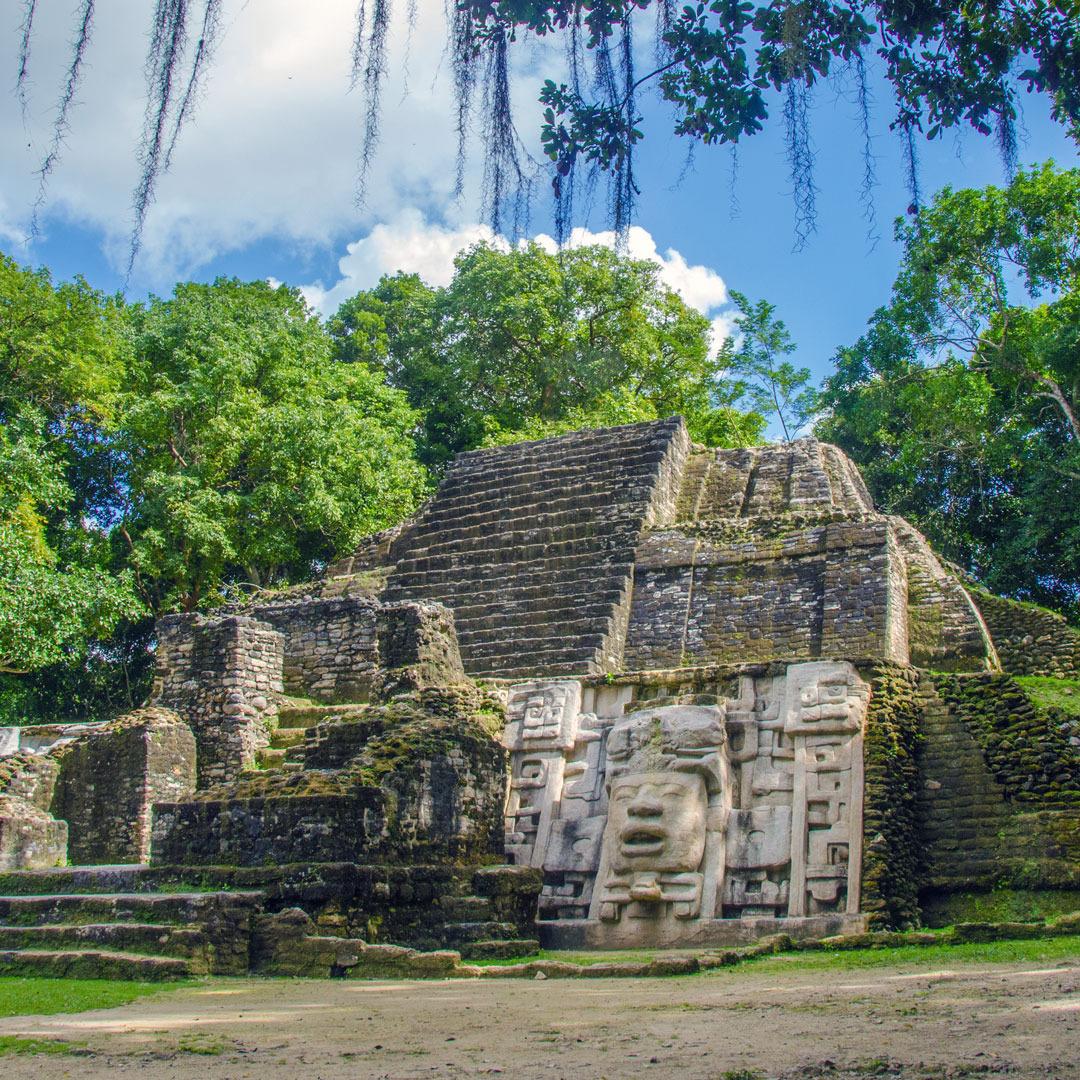
Getting There
All regional tour operators in Orange Walk, Corozal, and Belize City offer water tours to Lamanai. It is the most impressive way to approach the site, and a time-saver as well compared to going by land. Bob the crocodile and a group of spider monkeys have become regular tour stops, as they are accustomed to feeding routines. (Some boats invite spider monkeys on board to eat bananas, which should be discouraged; they can become aggressive toward people and cause serious injury.) Ask about night safaris, bird-watching tours, and sunrise trips up and down the New River.
Most hotels can arrange tours with licensed guides. Tours include the entrance fee, drinks, and usually a catered lunch as part of the deal; prices range US$40-70 per person. I highly recommend Lamanai River Tours (US$50 pp for 4 people, private tour US$230 for 3 people)—ask for guide Ignacio Lino, who knows the area inside out. Another option is Jungle River Tours (tel. 501/670-3035 or 501/629-3069, US$40 pp for a group of 4), with boats leaving from a landing near the historic La Inmaculada Catholic Church. Errol Cadle’s Lamanai Eco Tours (tel. 501/610-1753, US$50 pp for up to 10 people, includes lunch) caters to travelers who want a less frenetic pace, often from cruise ships.
Most visitors use one of the tour companies based in Orange Walk or the transfer services of their accommodations, but it is possible to do it yourself as well. A two-person boat transfer from Orange Walk should cost about US$125, less if you can get in with a bigger group. You can drive the San Felipe road in about 1.5 hours, depending on road conditions.
Newsletter Signup
By clicking ‘Sign Up,’ I acknowledge that I have read and agree to Hachette Book Group’s Privacy Policy and Terms of Use
Uxbenka Archaeological Site
The once difficult to access and largely unexcavated small site of Uxbenka—a name adapted from the phrase “old place” in Mopan Maya (Uchben’kaj) given to the site by the people of Santa Cruz—was discovered in 1984 and has more than 20 stelae; it’s also the oldest ancient city in Belize, in existence for over 2,000 years and continuously occupied for 1,000 years. The site is perched on a ridge overlooking the traditional Mayan village of Santa Cruz—the most authentic Maya village in Toledo, with 80 percent traditional homes, 129 families or 500 inhabitants—and provides a grand view of the foothills and valleys of the Maya Mountains. Here you’ll see hillsides lined with cut stones; this construction method is unique to the Toledo District.
In 2018, a new visitors center (9am-4pm; suggested donation US$5 pp) was opened, an initiative of Jose Mes, the village chairperson, who managed to reach an agreement for joint custody of the visitors center and the archaeological finds between the Santa Cruz community and the National Institute of Culture and History. All funds received go to maintaining the visitors center, the site, and surrounding caves. You can view the stelae there firsthand.
Getting There
Uxbenka is just at the entrance to Santa Cruz, about three miles west of San Antonio Village. The most convenient way to see the site is with a rental car. Contact the Uxbenka Kini’chahau Association (UKKA, tel. 501/628-9535, ask for Jose Mes) for more information and to book local guides. Mr. Mes is also happy to arrange for a Mayan experience right after your tour of the archaeological site, taking you into his home and sharing stories of Mayan culture.
Lubaantun Archaeological Site
Located on a ridge between two creeks, Lubaantun (Place of the Fallen Stones) consists of five layers of construction and is unique compared to other sites due to the absence of engraved stelae. The site was first reported in 1875 by American Civil War refugees from the southern United States and was first studied in 1915. It is believed that as many as 20,000 people lived in this former trading center.
Getting There
To reach Lubaantun from Punta Gorda, drive 1.5 miles west past the gas station to the Southern Highway, then take a right. Two miles farther, you’ll come to the village of San Pedro. From here, go left around the church to the concrete bridge. Cross and drive almost one mile—the road is passable during the dry season.

Marco Gonzalez Maya Site
Those looking for a little Mayan history right on the island can find it at the Marco Gonzalez Maya Site, just a 30-minute golf cart ride from San Pedro, at the south end of Ambergris Caye. Contact Jan Brown (tel. 501/662-2725, US$10 site, US$8 transportation), a passionate expat and the reserve’s chairperson, for a private guided tour of this virgin site. Currently under study, it was inhabited by the Maya for 1,600 years.
While the site continues to be preserved, cleaned, and examined for its history of the coastal Maya, it is literally a museum in the wild. A tour is an eco-adventure in itself, requiring careful navigation to avoid stepping on pieces of Mayan ceramics, with rainforest wildlife encounters along the way. Over the past few years, students have helped excavate parts of the site, revealing plaza structures and tombs. Human bones have been found, including skull fragments and skeletons as well as cutting tools made out of volcanic rock, thought to have been imported from Honduras and used for Mayan bloodletting rituals.
This may be the only place in the world where you can visit an ancient Mayan trading city on an island and spot pieces on the site that date back to 100 BC. On the way back to San Pedro, stop along the way to enjoy the scenic views from the south side, some of the most beautiful on Ambergris Caye.
Xunantunich Archaeological Site
One of Belize’s most impressive Mayan ceremonial centers, Xunantunich rests atop a natural limestone ridge with a grand view of the entire Cayo District and the Guatemalan countryside. The local name for the site, Xunantunich (shoo-NAHN-ta-nitch), or Stone Lady, continues to be used, even after the ancients’ own name for the site, Ka-at Witz, or Supernatural Mountain, was discovered, carved into a chunk of stone. In the summer of 2016, one of the largest tombs ever discovered in Belize was found at Xunantunich, lying 16-26 feet deep, and inside it were skeletal remains of a Maya leader, jade beads, vases, and other Mayan tools and artifacts.
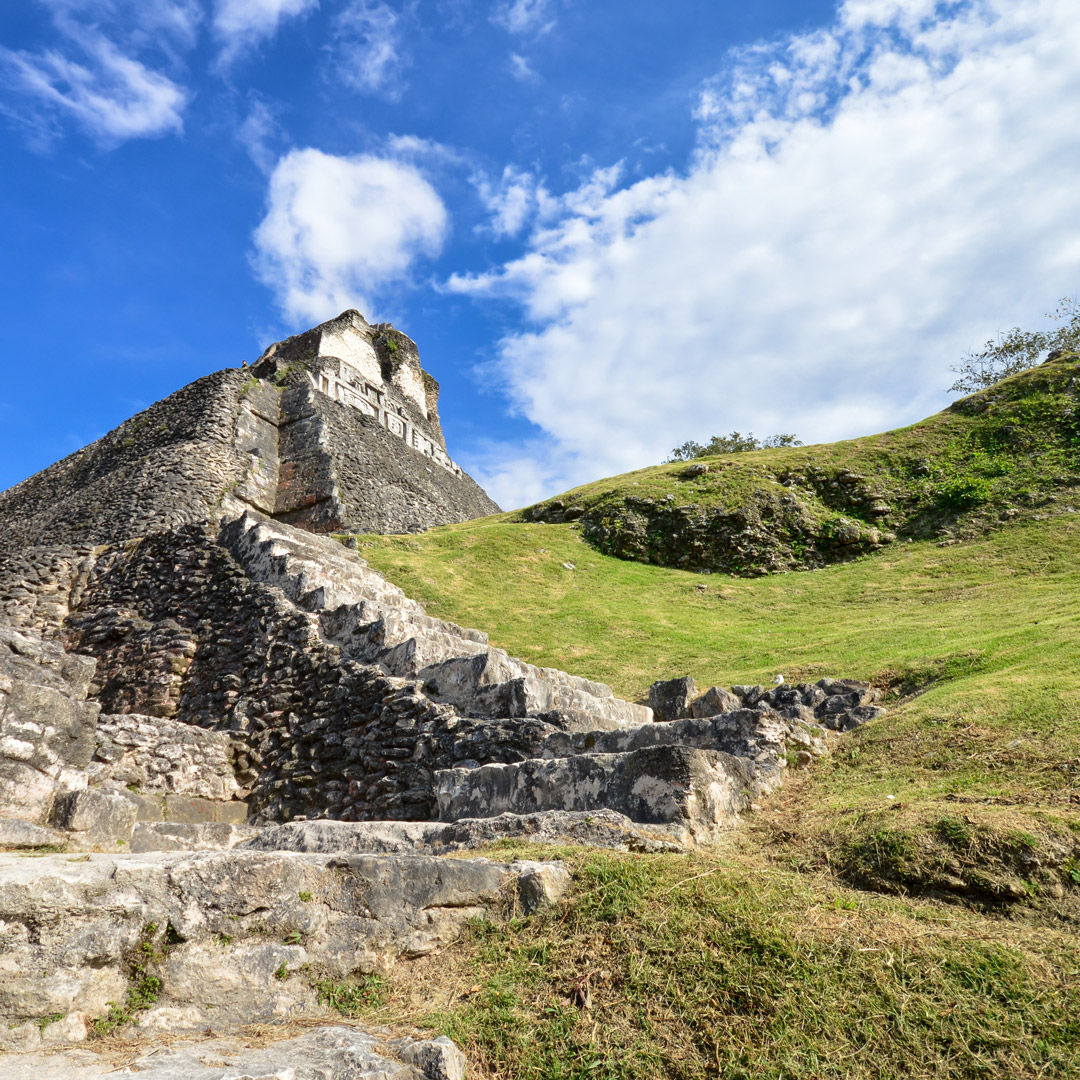
Getting There
Located eight miles west of San Ignacio, the site is accessed by crossing the Mopan River on the Succotz ferry, easily found at the end of a line of craft vendors. Buses ($0.75) and taxis (US$10 private or US$1.75 colectivo) can take you from San Ignacio to the ferry entrance. The hand-cranked ferry shuttles you (and your vehicle, if you have one) across the river, after which you’ll have a 30-minute, one-mile hike (or a 5-minute drive) up a steep hill to the site. The ferry, which operates 8am-3pm daily, is free, but tipping the operator is a much-appreciated gesture. Don’t miss the 4pm return ferry with the park rangers, or you’ll be swimming. Be forewarned that during the rainy season the Mopan River can rise, run fast, and flood, canceling this service and closing access to Xunantunich until conditions improve.
Entrance to the site is US$10 per person; guides are available for US$20 per group and recommended if you have the time—both to learn about what you’re seeing and to support sustainable tourism, as all guides are local and very knowledgeable. There’s a visitors center, just past the ticket booth, with beautiful and informative displays of Mayan history, Belize’s various archaeological sites, and the history of Xunantunich itself. It’s worth a stop here before continuing on your hike to the temples.
Cahal Pech Archaeological Site
A 10-minute walk uphill from downtown San Ignacio, Cahal Pech is a great tree-shaded destination filled with ancient tales. The ruins of Cahal Pech (Place of the Ticks) features an excavated series of plazas and royal residences. The site was discovered in the early 1950s, but research did not begin until 1988, when a team from San Diego State University’s anthropology department began work with local archaeology guru Jaime Awe. Thirty-four structures were built in a three-acre area. Excavation is ongoing, and visitors are welcome. It is well worth your trip and admission fee (US$5), paid at the Cahal Pech visitors center (tel. 501/824-4236, 8am-5pm daily). The visitors center also houses a small museum of artifacts found at the site, along with a skeleton from Xunantunich.
Nearby Tipu was a Christian Mayan town during the early years of colonization. Tipu was as far as the Spanish were able to penetrate in the 16th century.
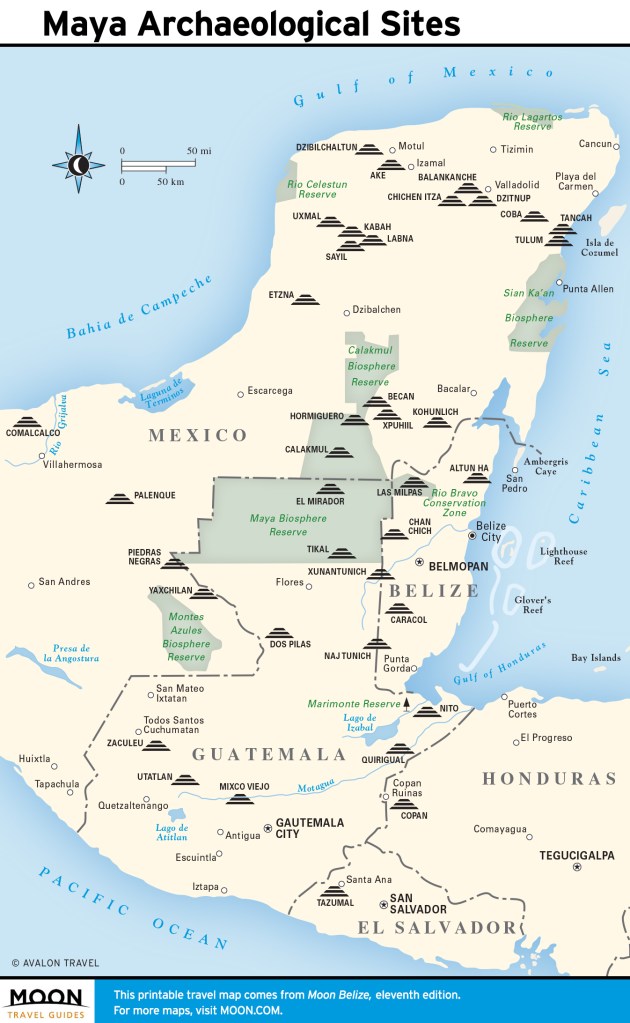
Newsletter Signup
By clicking ‘Sign Up,’ I acknowledge that I have read and agree to Hachette Book Group’s Privacy Policy and Terms of Use
Pin it for Later

